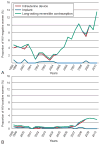Trends in contraceptive use among women with human immunodeficiency virus
- PMID: 22996095
- PMCID: PMC3449062
- DOI: 10.1097/AOG.0b013e318269c8bb
Trends in contraceptive use among women with human immunodeficiency virus
Abstract
Objective: To estimate trends in contraceptive use, especially long-acting reversible contraceptives (LARCs) and condoms, among human immunodeficiency virus (HIV)-seropositive and HIV-seronegative women.
Methods: Human immunodeficiency virus-seropositive and HIV-seronegative women in a multicenter longitudinal cohort were interviewed semiannually between 1998 and 2010 about sexual behaviors and contraceptive use. Trends in contraceptive use by women aged 18-45 years who were at risk for unintended pregnancy but not trying to conceive were analyzed using generalized estimating equations.
Results: Condoms were the dominant form of contraception for HIV-seropositive women and showed little change across time. Less than 15% of these women used no contraception. Between 1998 and 2010, LARC use increased among HIV-seronegative women from 4.8% (6 of 126) to 13.5% (19 of 141, P=.02), but not significantly among seropositive women (0.9% [4 of 438] to 2.8% [6 of 213], P=.09). Use of highly effective contraceptives, including pills, patches, rings, injectable progestin, implants, and intrauterine devices, ranged from 15.2% (53 of 348) in 1998 to 17.4% (37 of 213) in 2010 (P=.55). Human immunodeficiency virus-seronegative but not HIV-seropositive LARC users were less likely than nonusers to use condoms consistently (hazard ratio 0.51, 95% confidence interval [CI] 0.32-0.81, P=.004 for seronegative women; hazard ratio 1.09, 95% CI 0.96-1.23 for seropositive women).
Conclusion: Although most HIV-seropositive women use contraception, they rely primarily on condoms and have not experienced the increase in LARC use seen among seronegative women. Strategies to improve simultaneous use of condoms and LARC are needed to minimize risk of unintended pregnancy as well as HIV transmission and acquisition of sexually transmitted infections.
Level of evidence: II.
Figures


Similar articles
-
Long-Acting Reversible Contraception and Condom Use Among Female US High School Students: Implications for Sexually Transmitted Infection Prevention.JAMA Pediatr. 2016 May 1;170(5):428-34. doi: 10.1001/jamapediatrics.2016.0007. JAMA Pediatr. 2016. PMID: 26974492 Free PMC article.
-
Current contraceptive status among women aged 15-44: United States, 2011-2013.NCHS Data Brief. 2014 Dec;(173):1-8. NCHS Data Brief. 2014. PMID: 25500343
-
Contraceptive method and self-reported HIV status among women in Malawi.Contraception. 2017 Jun;95(6):558-563. doi: 10.1016/j.contraception.2017.03.001. Epub 2017 Mar 8. Contraception. 2017. PMID: 28285153
-
Canadian Contraception Consensus (Part 1 of 4).J Obstet Gynaecol Can. 2015 Oct;37(10):936-42. doi: 10.1016/s1701-2163(16)30033-0. J Obstet Gynaecol Can. 2015. PMID: 26606712 English, French.
-
Long-acting reversible contraception: a review in special populations.Pharmacotherapy. 2014 Jan;34(1):46-59. doi: 10.1002/phar.1358. Epub 2013 Oct 15. Pharmacotherapy. 2014. PMID: 24130075 Review.
Cited by
-
Decrease of condom use in heterosexual couples and its impact on pregnancy rates: the Swiss HIV Cohort Study (SHCS).HIV Med. 2022 Jan;23(1):60-69. doi: 10.1111/hiv.13152. Epub 2021 Sep 2. HIV Med. 2022. PMID: 34476886 Free PMC article.
-
Preconception counseling and care in the setting of HIV: clinical characteristics and comorbidities.Infect Dis Obstet Gynecol. 2015;2015:240613. doi: 10.1155/2015/240613. Epub 2015 Mar 8. Infect Dis Obstet Gynecol. 2015. PMID: 25838753 Free PMC article.
-
Hormonal Contraception and Risk of Psychiatric and Other Noncommunicable Diseases in HIV-Infected Women.J Womens Health (Larchmt). 2015 Jun;24(6):481-8. doi: 10.1089/jwh.2014.5003. Epub 2015 Mar 9. J Womens Health (Larchmt). 2015. PMID: 25751720 Free PMC article.
-
Contraception methods used among women with HIV starting antiretroviral therapy in a large United States clinical trial, 2009-2011.Contraception. 2021 Apr;103(4):225-231. doi: 10.1016/j.contraception.2020.11.004. Epub 2020 Nov 12. Contraception. 2021. PMID: 33189709 Free PMC article.
-
Medicaid Claims for Contraception Among Women With Medical Conditions After Release of the US Medical Eligibility Criteria for Contraceptive Use.Prev Chronic Dis. 2019 Jan 3;16:E03. doi: 10.5888/pcd16.180207. Prev Chronic Dis. 2019. PMID: 30605421 Free PMC article.
References
-
- Blumenthal PD, Voedisch A, Gemzell-Danielsson K. Strategies to prevent unintended pregnancy: increasing use of long-acting reversible contraception. Hum Reprod Update. 2011;17:121–37. - PubMed
-
- Mosher WD, Jones J. Use of contraception in the United States: 1982–2008. Vital Health Stat 23. 2010;29:1–44. - PubMed
-
- Kavanaugh ML, Jerman J, Hubacher D, Kost K, Finer LB. Characteristics of women in the United States who use long-acting reversible contraceptive methods. Obstet Gynecol. 2011;117:1349–57. - PubMed
Publication types
MeSH terms
Substances
Grants and funding
- UO1-HD-32632/HD/NICHD NIH HHS/United States
- UO1-AI-34994/AI/NIAID NIH HHS/United States
- UO1-AI-34989/AI/NIAID NIH HHS/United States
- U01 AI031834/AI/NIAID NIH HHS/United States
- U01 AI035004/AI/NIAID NIH HHS/United States
- UO1-AI-35004/AI/NIAID NIH HHS/United States
- UO1-AI-34993/AI/NIAID NIH HHS/United States
- U01 AI034994/AI/NIAID NIH HHS/United States
- P30 AI027763/AI/NIAID NIH HHS/United States
- UO1-AI-42590/AI/NIAID NIH HHS/United States
- U01 AI034993/AI/NIAID NIH HHS/United States
- UO1-AI-31834/AI/NIAID NIH HHS/United States
- UL1 RR024131/RR/NCRR NIH HHS/United States
- U01 AI034989/AI/NIAID NIH HHS/United States
- U01 HD032632/HD/NICHD NIH HHS/United States
- U01 AI042590/AI/NIAID NIH HHS/United States
LinkOut - more resources
Full Text Sources
Medical
Research Materials

